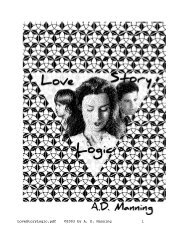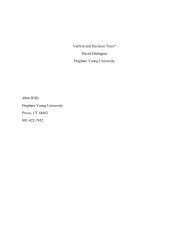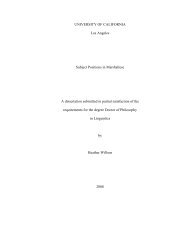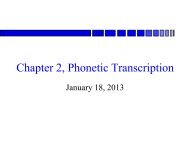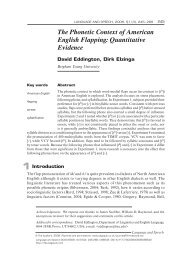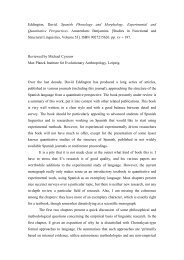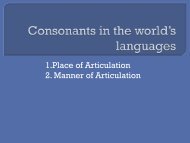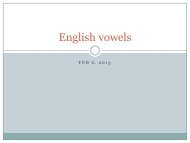A Brief Introduction to Marshallese Phonology (PDF) - Department of ...
A Brief Introduction to Marshallese Phonology (PDF) - Department of ...
A Brief Introduction to Marshallese Phonology (PDF) - Department of ...
You also want an ePaper? Increase the reach of your titles
YUMPU automatically turns print PDFs into web optimized ePapers that Google loves.
1. <strong>Introduction</strong><br />
A <strong>Brief</strong> <strong>Introduction</strong> <strong>to</strong> <strong>Marshallese</strong> <strong>Phonology</strong><br />
Heather Willson<br />
<strong>Marshallese</strong> is an Austronesian language spoken in the Republic <strong>of</strong> the Marshall Islands<br />
(RMI) located in Eastern Micronesia. The RMI consists <strong>of</strong> 34 a<strong>to</strong>lls comprising two chains: the<br />
Ratak Chain in the east and the Ralik Chain in the west. Each chain has a distinct dialect,<br />
although the two dialects are mutually intelligible. There are about 58,000 native speakers <strong>of</strong><br />
<strong>Marshallese</strong> living in the RMI, with small pockets <strong>of</strong> speakers scattered throughout Micronesia<br />
and the United States.<br />
This paper will provide a brief description <strong>of</strong> <strong>Marshallese</strong> phonology, including such<br />
<strong>to</strong>pics as the phoneme inven<strong>to</strong>ry, vowel dissimilation, consonant sequence constraints, syllable<br />
structure and reduplication. In the second half <strong>of</strong> this work, a more in-depth analysis <strong>of</strong> vowel<br />
underspecification, consonant geminate sequences and reduplication will be presented.<br />
2. <strong>Marshallese</strong> Phoneme Inven<strong>to</strong>ry<br />
The <strong>Marshallese</strong> phoneme system has been well researched and described. In this<br />
section, I will first describe the consonant and then the vowel systems.<br />
2.1 Consonants<br />
<strong>Marshallese</strong> has a large consonant system. Each consonant has a primary and a<br />
secondary articulation site (Choi (1992)). There are three primary sites- bilabial, coronal and<br />
velar- and three secondary articulations- palatalization, velarization and rounding. However all<br />
places <strong>of</strong> articulation do no exhibit all three secondary articulations, as shown in Table 1. While<br />
there is an oral-nasal contrast, there is no voicing contrast.
Table 1. <strong>Marshallese</strong> consonant inven<strong>to</strong>ry (adapted from Choi (1992)).<br />
Bilabials Coronals Velars<br />
Palatalized p j t j<br />
S<strong>to</strong>ps Velarized p ƒ t ƒ k<br />
Rounded k w<br />
Palatalized m j n j<br />
Nasals Velarized m ƒ n ƒ N<br />
Rounded n w N w<br />
Palatalized l j<br />
Liquids Velarized l ƒ r ƒ<br />
Rounded l w r w<br />
Palatalized j<br />
Glides Velarized Â<br />
Rounded w<br />
Table 1 also shows that <strong>Marshallese</strong> contains three semi-consonants /j/, /w/ and /Â/<br />
2.2 Vowels<br />
<strong>Marshallese</strong> has four vowel phonemes. These phonemes are specified for [height] and<br />
[ATR] but are not for [back] and [round]. Hale (2000) refers <strong>to</strong> these phonemes as cup <strong>of</strong> c<strong>of</strong>fee,<br />
, ☯, and soccer ball. I will follow a more standard convention and refer <strong>to</strong> them as<br />
[+hi, +ATR], [+hi, -ATR], [-hi, +ATR], [-hi, -ATR], while I will refer <strong>to</strong> the surface forms <strong>of</strong><br />
these phonemes by the symbols represented in Table 2. <strong>Marshallese</strong> vowels are assigned the<br />
qualities [back] and [round] by the surrounding consonants. Vowels become [-back, -round] in<br />
the environment <strong>of</strong> palatalized consonants, [+back, - round] in the environment <strong>of</strong> velarized<br />
consonants and [+back, +round] in the environment <strong>of</strong> labialized consonants. There are,<br />
therefore, twelve vowels which appear in the surface form <strong>of</strong> <strong>Marshallese</strong>:
Table 2. <strong>Marshallese</strong> Vowel Allophones<br />
[-back, -round] [+back, -round] [+back, +round]<br />
[+hi, +ATR] i µ u<br />
[+hi, -ATR] I F U<br />
[-hi, +ATR] e √ o<br />
[-hi, -ATR] E a ç<br />
When a vowel appears between consonants that have different secondary places <strong>of</strong> articulation,<br />
the vowel retains its height specification but consists <strong>of</strong> a smooth transition from one target <strong>to</strong><br />
another (Bender (1968), Choi (1992)). For example if a vowel is found in the environment<br />
C j VC w , there is steady movement <strong>of</strong> the <strong>to</strong>ngue throughout the vowel from a [-back, -round] <strong>to</strong> a<br />
[+back, +round] position, such as in jok ‘shy’ where there is a transition between [e] and [o]:<br />
/t j eok w /. In other words, [eo] is a dipthong. There are therefore twenty four <strong>Marshallese</strong><br />
diphthongs, six at each specification <strong>of</strong> height and ATR.<br />
3. Vowel Dissimilation<br />
Table 3. <strong>Marshallese</strong> Dipthongs<br />
iµ iu µi µu ui uµ<br />
IF IU FI FU UI UF<br />
e√ eo √e √o oe o√<br />
Ea Eç aE aç ç ça<br />
Vowel dissimilation occurs in the 3 rd person suffixed form <strong>of</strong> certain nouns. These forms<br />
contain a [-hi,-ATR]C[-hi,-ATR] sequence in which the first vowel dissimilates from the second<br />
and becomes a [-hi,+ATR] vowel. However dissimilation occurs only when the second vowel is<br />
not deleted or not destined <strong>to</strong> be (Bender (1969b). Thus both vowels must occur on the surface.<br />
As shown in Table 4, the independent form retains its [-hi,-ATR] vowel since it is not followed<br />
by [-hi,-ATR] vowel. However, the [-hi,-ATR] vowel <strong>of</strong> the 3 rd person singular suffix created<br />
the environment for vowel dissimilation.
Table 4. <strong>Marshallese</strong> Vowel Dissimilation<br />
English independent form 3 rd sing suffixed form<br />
head p ƒ ar ƒ p ƒ √r ƒ aEn j<br />
name jEat ƒ je√t ƒ aEn j<br />
eye m j Et j m j et j En j<br />
While a dissimilation process provides an accurate description <strong>of</strong> the forms in Table 4,<br />
Bender (1969b) admits there is some validity <strong>to</strong> the alternative explanation that the 3 rd singular<br />
form contains the unaltered [-hi,+ATR] form and that this vowel is becomes [-hi,-ATR] in the<br />
independent form. However, this alternation would have <strong>to</strong> be restricted <strong>to</strong> disyllabic forms<br />
because neither assimilation nor dissimilation occurs when there are more than two syllables.<br />
Table 5. <strong>Marshallese</strong> forms with neither assimilation nor dissimilation<br />
English independent form 3 rd sing<br />
bigness kµil j ep j kµil j ep j En j<br />
If an assimilation analysis is adopted, then the second vowel <strong>of</strong> the stem in the independent form<br />
in Table 5 should become a [-hi,-ATR] vowel. However, since this does not occur, Bender<br />
rejects the assimilation analysis in favor <strong>of</strong> the dissimilation analysis. Under this analysis, the<br />
[-hi,+ATR]C[-hi,-ATR] vowel sequence <strong>of</strong> the 3 rd singular form in Table 5 is not the correct<br />
environment for dissimilation, so dissimilation does not apply. Thus only a dissimilation<br />
analysis can account for the data.<br />
4. Consonant Sequences<br />
<strong>Marshallese</strong> only allows homorganic consonant sequences. 1 When there is a non-<br />
homorganic sequence, the sequence is separated by excrescence (McClin<strong>to</strong>ck (1999)). This<br />
process can occur within a word or across a word boundary. Additionally, even though a<br />
1 When the term “homorganic” is used, only the primary articulation site is considered.
consonant sequence may be homorganic, certain sequences are not allowed and are eliminated<br />
either by excrescence or assimilation <strong>to</strong> the secondary place <strong>of</strong> articulation, as summarized in<br />
table 6.<br />
Table 6. <strong>Marshallese</strong> Consonant Sequences (adapted from McClin<strong>to</strong>ck (1999))<br />
Homorganic sequence Non-homorganic sequence<br />
Obstruent-Obstruent palatal/velar assimilation excrescence<br />
Nasal-Nasal palatal/velar assimilation excrescence<br />
Liquid-Liquid palatal/velar assimilation excrescence<br />
Nasal-Obstruent palatal/velar assimilation excrescence<br />
Liquid-Obstruent (except /l j t F / & /l F t F /) excrescence excrescence<br />
Obstruent-Nasal [+coronal] = excrescence excrescence<br />
[-coronal] = nasal assimilation excrescence<br />
Obstruent-Liquid excrescence excrescence<br />
Liquid-Nasal nasal assimilation excrescence<br />
Nasal-Liquid palatal/velar assimilation excrescence<br />
In the remainder <strong>of</strong> this section, I will focus solely on homorganic sequences, since there is little<br />
<strong>to</strong> say about non-homorganic ones.<br />
4.1 Geminates<br />
Geminates may appear morpheme internally and stem initially (Bender (1968)).<br />
However, geminates do not appear word initially. The two dialects <strong>of</strong> <strong>Marshallese</strong>- the eastern<br />
Ratak dialect and the western Ralik dialect- have different surface forms for words which could<br />
potentially have an initial geminate sequence in the UR. (This claim regarding the UR will be<br />
justified later in the paper.) The Ratak chain has a vowel intervening between the geminate<br />
consonants, while the Ralik chain has adds a vowel word initially (Bender 1969a).<br />
Table 7. Initial geminate sequences (from McClin<strong>to</strong>ck (1999))<br />
English Ralik Ratak<br />
‘good’ m ƒ am ƒ aEn j jEam ƒ m ƒ aEn j<br />
‘feel unworthy’ p j Ep j Eat ƒ jEp j p j Eat ƒ<br />
‘angry’ l j il j iuw jil j l j iuw
4.2 Consonant Sequence Assimilation<br />
Consonant sequence assimilation occurs in obstruent-obstruent, nasal-obstruent and<br />
nasal-liquid sequences. Obstruent-obstruent sequence assimilation occurs when the two<br />
obstruents differ in secondary place <strong>of</strong> articulation. Assimilation is regressive, shown in Table 8.<br />
Table 8. <strong>Marshallese</strong> Consonant Assimilation (from McClin<strong>to</strong>ck (1999))<br />
Sequence type Consonants<br />
labial s<strong>to</strong>p p ƒ /p j p ƒ p j ? p j p j p j p ƒ ? p ƒ p ƒ<br />
coronal s<strong>to</strong>p t ƒ /t j t ƒ t j ? t j t j t j t ƒ ? t ƒ t ƒ<br />
bilabial nasal m ƒ /m j m ƒ m j ? m j m j m j m ƒ ? m ƒ m ƒ<br />
coronal nasal n ƒ /n j n ƒ n j ? n j n j n j n ƒ ? n ƒ n ƒ<br />
lateral l ƒ /l j l ƒ l j ? l j l j l j l ƒ ? l ƒ l ƒ<br />
retr<strong>of</strong>lex r ƒ /r j r ƒ r j ? r j r j r j r ƒ ? r ƒ r ƒ<br />
Regressive assimilation also occurs with nasal-obstruent and nasal-liquid sequences. However,<br />
in obstruent-nasal sequences, nasal assimilation occurs if the nasal is [-coronal]. (If the nasal is<br />
[+coronal] excrescence occurs.) Nasal assimilation can occur within words as well as across<br />
word boundaries, as in lep mouj “white eggs”, which becomes [l j Em j m j ou9t j ]. Regressive<br />
Assimilation is also triggered by liquid-nasal sequences, as in the place name Arno, which<br />
becomes a[n ƒ n ƒ ]o.<br />
Further, rounding assimilation may also occur with liquid and nasal/non-nasal velar<br />
consonants. The direction <strong>of</strong> assimilation may be both regressive and progressive, as shown in<br />
(1) 2 :<br />
(1) <strong>Marshallese</strong> Regressive rounding assimilation<br />
[p ƒ √k] ‘take’ bo[k w k w ]eet ne ‘take that oc<strong>to</strong>pus’<br />
<strong>Marshallese</strong> Progressive rounding assimilation<br />
[k√] question particle ear i<strong>to</strong>[k w k w ]e ‘Did he/she come?’<br />
4.3 Excrescence<br />
2 In (3), I have shown only the relevant assimilation in IPA, leaving the rest <strong>of</strong> the sentence in <strong>Marshallese</strong><br />
orthography.
There are three homorganic sequences which trigger excrescence: obstruent-liquid,<br />
liquid-obstruent (with the exception <strong>of</strong> /l j t F / and /l F t F / in which neither assimilation nor<br />
excrescence occurs) and obstruent-nasal when the nasal is [+coronal]. For coronal nasals,<br />
excrescence can occur word internally, as in ‘curious’ kajnet [kåt ƒ aEn j Et j ], or across a word<br />
boundary, as in ‘that watch’ waj ne- [wçat ƒ √e n j E]. When excrescence occurs across a word<br />
boundary, the vowel is still a smooth transition from one target <strong>to</strong> another.<br />
5. Syllable Structure<br />
<strong>Marshallese</strong> syllable structure may be CV, CVC, or VC. <strong>Marshallese</strong> does not allow<br />
complex onsets or codas. Further, what appears <strong>to</strong> be long vowel are in fact V1GV1 sequences,<br />
where /G/ = {/j/, /w/, /Â/} (Bender 1968). For example the word naj ‘future’ contains the long<br />
medial vowel [a]. In this word, both consonants are palatalized, yet the vowel is not [-back] as it<br />
should be in the environment <strong>of</strong> palatalized consonants. Instead, this vowel is [+back, -round].<br />
Thus there must be something pulling the vowel <strong>to</strong>wards [+back,-round] qualities. If the long<br />
vowel is in fact VGV, then there is an explanation for vowel quality. Thus the correct phonetic<br />
form for ‘future’ is [n j eaÂaet j ]. It is <strong>of</strong> course possible that the word was transcribed incorrectly<br />
and the long vowel is [e], in which case there would be no need for positing a glide. However<br />
the vast number <strong>of</strong> <strong>Marshallese</strong> words which would have been transcribed incorrectly leaves this<br />
option in doubt.<br />
There is empirical evidence which supports the claim that there is a glide in this<br />
sequence. In an acoustical analysis, Choi (1992) examined the F2 trajec<strong>to</strong>ries <strong>of</strong> CGC “long<br />
vowels” versus short vowels. While there was not significant difference between the trajec<strong>to</strong>ries<br />
<strong>of</strong> long and short vowels where the consonant and glides bore the same secondary articulation-<br />
/t ƒ ap ƒ / vs. /t ƒ aÂap ƒ /- there was a significant difference between /t i ap j / vs. /t j aÂap j / as well as
instances where the two consonants had different secondary articulation. From these results,<br />
Choi concludes that Bender’s analysis correctly predicts dipthongs with F2 transition patterns<br />
that contrast with those in short vowels. However, Choi also concludes that there is no evidence<br />
that the glide is present phonetically. Despite this fact, he does not rule out the possibility that<br />
this glide could exist as “a deeper level <strong>of</strong> representation” (71).<br />
More Support for Bender’s analysis comes from prosodic weight. McClin<strong>to</strong>ck (1999)<br />
explains that only final consonants may carry prosodic weight. Under this analysis, the syllable<br />
structure <strong>of</strong> [jEn j t ƒ åÂ] is:<br />
(2) s s<br />
µ µ µ µ<br />
j E n j t ƒ å Â<br />
Due <strong>to</strong> the fact that complex consonants and codas are not allowed in <strong>Marshallese</strong>, it can be<br />
conluded that <strong>Marshallese</strong> does not allow super-heavy syllables. If this is the case, then the<br />
inadmissibility <strong>of</strong> CVVC syllables is explained. Since both vowels and the coda bear prosodic<br />
weight, a CVVC sequence would result in a super-heavy syllable. Further a CV1{y, w, h}V1C<br />
syllable structure would not create super-heavy syllables.<br />
6. Reduplication 3<br />
<strong>Marshallese</strong> reduplication occurs for a variety <strong>of</strong> morpho-semantic reasons, which will be<br />
discussed briefly before types <strong>of</strong> reduplication are introduced. The primary reasons for<br />
reduplication are 1) the derivation <strong>of</strong> verbs from nouns, 2) the derivation <strong>of</strong> intransitive verbs<br />
3 In the discussion <strong>of</strong> reduplication, examples are taken from Bender (1969) and (1973), Harrison (1973) and Zewen<br />
(1977).
from their transitive counterparts, 3) the formation <strong>of</strong> ‘distributive’ verbs and 4) the formation <strong>of</strong><br />
special forms <strong>of</strong> numbers (Bender (1971)) 4 .<br />
The derivation <strong>of</strong> verbs from nouns requires little explanation except <strong>to</strong> say that a noun<br />
can become a verb through the process <strong>of</strong> reduplication, as in (3):<br />
(3) t ƒ µ? ‘sound <strong>of</strong> hitting or chopping t ƒ µ?t ƒ µ? ‘<strong>to</strong> make a ti? sound’<br />
wça ‘canoe’ wçaÂwça ‘go by canoe’<br />
wçEt j ‘watch’ wçEt j wçEt j ‘wear a watch’<br />
Likewise the derivation <strong>of</strong> intransitive from transitive verbs is also simple, with one exception.<br />
For many in transitive verbs, there are segments which are not in the reduplicated intransitive<br />
form:<br />
(4) m ƒ µit j iµt ƒ ‘<strong>to</strong> cut’ trans. m ƒ µit j m ƒ µit j ‘<strong>to</strong> cut’ intrans.<br />
?ar ƒ µit j ‘<strong>to</strong> bite (the dust)’ trans. ?ar ƒ ?ar ƒ ‘<strong>to</strong> bite (the dust)’ intrans<br />
n ƒ √ow ‘<strong>to</strong> pound’ trans. n ƒ √own ƒ √ow ‘<strong>to</strong> pound’ intrans.<br />
The first two examples in (4) show that the endings -it and –ij are not included in the intransitive<br />
form. It is possible that these are some sort <strong>of</strong> transitive endings, but this issue is not yet clear.<br />
Reduplication may also occur with distributive forms <strong>of</strong> verbs and nouns. The<br />
distributive signifies a general spreading out, distribution, or intensification <strong>of</strong> an action:<br />
(5) p ƒ ar ƒ ‘rocks along the shore’ p ƒ ar ƒ p ƒ ar ƒ ‘full <strong>of</strong> rocks along the shore’.<br />
k ƒ ap ƒ wuµl ƒ √? ‘<strong>to</strong> cause surprise’ k ƒ ap ƒ p ƒ w uµl ƒ √?l ƒ √? ‘cause great surprise’<br />
p j ijEçw ‘chilly’ p j p j ijEçwyeow ‘sensitive <strong>to</strong> chills’<br />
Finally reduplication can be used <strong>to</strong> form special verbs from numbers. These verbs have the<br />
meaning ‘<strong>to</strong> count by.”<br />
4 Bender also claims that reduplication can derive a postpositional adjective from a stative verb. However it is<br />
unclear whether these “statives” are verbs or if they are really adjectives with a silent copula. For some forms, what<br />
Bender claims is a postpositional form, Gaiun (PC) describes as having a distributive meaning. Thus it is possible<br />
that these forms are in fact distributives. Due <strong>to</strong> this discrepancy and the fact that there syntactic issues which need<br />
<strong>to</strong> be resolved first, I have chosen not <strong>to</strong> include postpositionals in reasons for reduplication. Their reduplicative<br />
form, however, is similar <strong>to</strong> other forms, and therefore, this exclusion will not affect the analysis <strong>of</strong> reduplication.
6.1 Types <strong>of</strong> Reduplication<br />
There are four types <strong>of</strong> reduplication in <strong>Marshallese</strong>: full reduplication, right edge<br />
reduplication, left edge reduplication and doubling (Bender (1971), (Harrison (1973)). These<br />
four types <strong>of</strong> reduplication do not correspond <strong>to</strong> the four functions <strong>of</strong> reduplication, i.e. the<br />
distributive can be formed through doubling, right edge reduplication or both, intransitive can be<br />
formed through doubling or full reduplication, etc.<br />
6.1.1 Full Reduplication<br />
Full reduplication consists <strong>of</strong> the reduplication <strong>of</strong> the entire word. However this type <strong>of</strong><br />
reduplication rarely occurs when the word consists <strong>of</strong> more than one syllable. While it might be<br />
possible that full reduplication is actually right or left edge reduplication, this cannot be seen<br />
determined from the surface forms. Full reduplication occurs for the formation <strong>of</strong> the<br />
distributive, the derivation <strong>of</strong> a verb from a noun and intransitive verb formation.<br />
Table 9. Intransitive full reduplication<br />
n ƒ √ow ‘<strong>to</strong> pound’ n ƒ √own ƒ √ow ‘<strong>to</strong> pound’<br />
p j e√r ƒ ‘<strong>to</strong> doubt’ p j e√r ƒ p j e√r ƒ ‘<strong>to</strong> doubt’<br />
Table 10. Distributive full reduplication<br />
p ƒ ar ƒ ‘rocks along the shore’ p ƒ ar ƒ p ƒ ar ƒ ‘full <strong>of</strong> rocks along the shore’<br />
p ƒ at ƒ ‘hill’ p ƒ at ƒ p ƒ at ƒ ‘full <strong>of</strong> hills’<br />
p ƒ √ok w ‘sand’ p ƒ √ok w p ƒ √ok w ‘full <strong>of</strong> sand’<br />
r ƒ √t ƒ ‘sunshine’ r ƒ √t ƒ r ƒ √t ƒ ‘full <strong>of</strong> sunshine’<br />
r ƒ µij ‘bone’ r ƒ µijr ƒ µij ‘boney<br />
r ƒ √? ‘hear’ r ƒ √?r ƒ √? ‘hear well’<br />
t ƒ √ol w ‘mountain’ t ƒ √ol w t ƒ √ol w ‘full <strong>of</strong> mountains’<br />
Table 11. Noun <strong>to</strong> verb full reduplication<br />
Âat ƒ ‘hat’ Âat ƒ Âat ƒ ‘wear a hat’<br />
k ƒ al ƒ ‘loincloth’ k ƒ al ƒ k ƒ al ƒ ‘wear a loincloth’<br />
k ƒ √t ƒ ‘call <strong>of</strong> a turns<strong>to</strong>ne (bird)’ k ƒ √t ƒ k ƒ √t ƒ ‘<strong>to</strong> make the call <strong>of</strong> a turns<strong>to</strong>ne
m ƒ aEt j ‘glasses’ m ƒ aEt j m ƒ aEt j ‘wear glasses’<br />
?Âr ƒ ‘sound <strong>of</strong> groaning’ ?Âr ƒ ?Âr ƒ ‘<strong>to</strong> groan/grunt’<br />
t ƒ Â? ‘sound <strong>of</strong> hitting or chopping’ t ƒ Â?t ƒ Â? ‘<strong>to</strong> make a ti? sound’<br />
wça ‘canoe’ wçaÂwça ‘go by canoe’<br />
wçEt j ‘watch’ wçEt j wçEt j ‘wear a watch’<br />
wuµt ƒ ‘flower’ wuµt ƒ wuµt ƒ ‘wear a flower’<br />
6.1.2 Right Edge Reduplication<br />
Right edge reduplication occurs when the base has more than one syllable. In these<br />
instances, the right syllable is reduplicated.<br />
Table 12. Distributive right edge reduplication.<br />
Âar ƒ r ƒ µm ƒ √et j ‘feeble’ Âar ƒ r ƒ µm ƒ √et j m ƒ √et j ‘very feeble’<br />
Table 13. Noun <strong>to</strong> verb right edge reduplication<br />
p ƒ aÂat ƒ ‘smoke’ p ƒ aÂat ƒ Âat ƒ ‘<strong>to</strong> smoke’<br />
t j e√Â√et j ‘shirt’ t j e√Â√et j Â√et j ‘<strong>to</strong> wear a shirt’<br />
t j eok w o√n ƒ ‘walking stick’ t j eok w o√n ƒ k w o√n ƒ ‘<strong>to</strong> use walking stick’<br />
t j eowo√p ƒ ‘soap’ t j eowo√p ƒ wo√p ƒ ‘<strong>to</strong> be soapy’<br />
t j iuwiut j ‘shoes’ t j iuwiut j wiut j ‘<strong>to</strong> wear shoes’<br />
k ƒ a?µr ƒ ‘belt’ k ƒ a?µr ƒ ?µr ƒ ‘<strong>to</strong> wear a belt’<br />
k ƒ açwçEt j ‘blanket’ k ƒ açwçEt j wçEt j ‘<strong>to</strong> use a blanket’<br />
k ƒ √owo√l ƒ ‘hair’ k ƒ √owo√l ƒ wo√l ƒ ‘<strong>to</strong> be hairy’<br />
Table 14. Right edge reduplication for intransitive verbs.<br />
Âat ƒ µit j iµk ƒ ‘<strong>to</strong> smoke’ Âat ƒ µit j iµk ƒ t j iµk ƒ ‘<strong>to</strong> smoke fish or copra’<br />
k ƒ al ƒ √Â√r ƒ ‘<strong>to</strong> drive in the ground’ k ƒ al ƒ √Â√r ƒ Â√r ƒ ‘upside down’<br />
jiµl ƒ √ejiµk ƒ ‘<strong>to</strong> string’ jiµl ƒ √ejiµk ƒ jiµk ƒ ‘<strong>to</strong> string’<br />
6.1.3 Left Edge Reduplication<br />
Bender (1971) gives only one form <strong>of</strong> left edge reduplication:<br />
Table 15. Left edge reduplication<br />
jet j Eal ƒ ‘<strong>to</strong> go’ jejet j Eal ƒ ‘<strong>to</strong> walk’
While [jejet j Eal ƒ ] seems <strong>to</strong> be formed by reduplication, it does not have a reduplicative meaning<br />
that falls in<strong>to</strong> one <strong>of</strong> the morph-semantic category. Further Abo (1976) does not list this word as<br />
a reduplicated form. It is probably that there are more convincing examples <strong>of</strong> left edge<br />
reduplication, but more research will need <strong>to</strong> be done <strong>to</strong> uncover them.<br />
6.1.4 Doubling<br />
Doubling consists <strong>of</strong> the reduplication <strong>of</strong> a syllable initial consonant. In many instances,<br />
it is the initial syllable <strong>of</strong> the stem, but as is shown by number doubling, this is not always the<br />
case. In number doubling, the causative prefix ka- is also added <strong>to</strong> the right edge <strong>of</strong> the word.<br />
Table 16. Number doubling<br />
t j iuwu√n ƒ ‘one’ k ƒ aEt j t j iuw ‘count by ones’<br />
r ƒ µuwow ‘two’ k ƒ ar ƒ r ƒ µuwwow ‘count by twos’<br />
t j iµl ƒ µuw ‘three’ k ƒ aEt j t j iµl ƒ l ƒ µuw ‘count by threes’<br />
je√m ƒ an ƒ ‘four’ k ƒ aEje√m ƒ m ƒ an ƒ ‘count by fours’<br />
l ƒ al ƒ √m ƒ ‘five’ k ƒ al ƒ l ƒ al ƒ l ƒ √m ƒ ‘count by fives’<br />
t j iµl ƒ t j iµn ƒ √ow ‘six’ k ƒ aEt j t j iµl ƒ t j iµn ƒ √ow ‘count by sixes’<br />
Table 16. Intransitive verb doubling<br />
t j iµb ƒ µr ƒ ‘<strong>to</strong> hug’ t j t j iµb ƒ µr ƒ ‘<strong>to</strong> hug’<br />
k ƒ al ƒ ‘<strong>to</strong> build’ k ƒ k ƒ al ƒ ‘<strong>to</strong> build’<br />
k ƒ µn ƒ ‘<strong>to</strong> invent’ k ƒ k ƒ µn ƒ ‘<strong>to</strong> invent’<br />
k ƒ µr ƒ ‘<strong>to</strong> call’ k ƒ k ƒ µr ƒ ‘<strong>to</strong> call’<br />
l ƒ iuw ‘<strong>to</strong> scold’ ll ƒ iuw ‘<strong>to</strong> be angry’<br />
p j iµk ƒ ‘<strong>to</strong> look for’ p j p j e√k ƒ ‘<strong>to</strong> look for’<br />
k w uµn ƒ ‘<strong>to</strong> extinguish’ k w k w uµn ƒ ‘<strong>to</strong> extinguish’<br />
Doubling may also be combined with right edge reduplication <strong>to</strong> form the distributive.<br />
Table 18. Distributive right edge reduplication and doubling<br />
p ƒ aÂwow ‘chicken’ p ƒ p ƒ aÂwowwow ‘full <strong>of</strong> chickens<br />
p ƒ ar ƒ µuw ‘crab’ p ƒ p ƒ ar ƒ µuwr ƒ µuw ‘full <strong>of</strong> crab’<br />
r j e√k ƒ ak ƒ ‘s<strong>to</strong>ne’ r j r j e√k ƒ ak ƒ k ƒ ak ƒ ‘full <strong>of</strong> rocks’<br />
r j ijl ƒ a ‘nail’ r j r j ijl ƒ aÂl ƒ a ‘have many nails’
t j e√k ƒ ab ƒ ‘checkered’ t j t j e√k ƒ ab ƒ k ƒ ab ƒ ‘checkered all over’<br />
t j e?açw ‘odor <strong>of</strong> fish’ t j t j e?açw?açw ‘permeated with fish odor’<br />
t j eçwçak ƒ ‘ashamed’ t j t j eçwçak ƒ wçak ƒ ‘easily ashamed’<br />
k ƒ ab ƒ wuµl ƒ √? ‘<strong>to</strong> cause surprise’ k ƒ k ƒ ab ƒ wuµl ƒ √? l ƒ √? ‘cause great surprise’<br />
k ƒ ar ƒ t j iµn ƒ ‘kerosene’ k ƒ k ƒ ar ƒ t j iµn ƒ t j iµn ƒ ‘smell <strong>of</strong> kerosene’<br />
6.1.5 Ambiguous Reduplication<br />
As was stated in the beginning <strong>of</strong> this section, transitive verbs have segments that are<br />
both not reduplicated in the intransitive form and are deleted. Thus it is unclear as <strong>to</strong> what type<br />
<strong>of</strong> reduplication is occurring. I will put <strong>of</strong>f labeling these in this descriptive portion <strong>of</strong> the paper<br />
and will refer <strong>to</strong> them as “ambiguous” for the time being.<br />
Table 19. Intransitive ambiguous reduplication<br />
m ƒ µit j iµt ƒ ‘<strong>to</strong> cut’ m ƒ µit j m ƒ µit j ‘<strong>to</strong> cut’<br />
p j Eçwuµn ƒ ‘<strong>to</strong> bind’ p j Eçwp j e√w ‘<strong>to</strong> coil up’<br />
r ƒ ak ƒ µit j ‘<strong>to</strong> clean an area’ r ƒ aÂr ƒ √ ‘<strong>to</strong> clean up’<br />
r ƒ açk w uit j ‘<strong>to</strong> scratch’ r ƒ açk w r ƒ √ok w ‘<strong>to</strong> scoop up’<br />
t ƒ aEt j iµk ƒ ‘<strong>to</strong> wind up’ t ƒ aEjt ƒ √et j ‘<strong>to</strong> wind/roll up’<br />
jEat ƒ µt ƒ ‘<strong>to</strong> smell’ jEat ƒ jEat ƒ ‘<strong>to</strong> smell’<br />
6.2 Part 1 Conclusion<br />
In this section, I have examined some <strong>of</strong> the major features <strong>of</strong> <strong>Marshallese</strong> phonology. In<br />
section 7, I will examine a vowel underspecification, geminates and reduplication in more detail<br />
with the hopes <strong>of</strong> providing possible analyses for the issues raised in part 1.<br />
7. Vowel Underspecification<br />
In order <strong>to</strong> account for <strong>Marshallese</strong> vowel underspecification, Hale, following Keating<br />
(1988), suggests three levels <strong>of</strong> representation in the production <strong>of</strong> the vowels: the phonological<br />
representation /…/ , the phonetic representation […], and the acoustic/articula<strong>to</strong>ry representation<br />
[…]. Only at the acoustic/articula<strong>to</strong>ry representation do vowels become specified, since it is
at this level that specification must be determined in order <strong>to</strong> be produced. (6), adapted from<br />
Hale, represents the derivation <strong>of</strong> two <strong>Marshallese</strong> words:<br />
(6) a. CpalatalizedVCvelarized: /n j [-high,+ATR]t ƒ / > [n j [-high,+ATR]t ƒ ] > [n j e√t ƒ ] - squid<br />
b. CpalatalizedVCpalatalized: /t j [-high,-ATR]t j / > [t j [-high,-ATR]t j ] > [t j Et j ] - Lutjanus Flavipes<br />
This analysis has been confirmed by Choi (1992), who showed that F1 was an inherent property<br />
<strong>of</strong> the vowel, while F2 was determined by the property <strong>of</strong> the surrounding consonants. Further,<br />
movement <strong>of</strong> F2 between consonants with different secondary places <strong>of</strong> articulation confirmed<br />
interpolation, the movement from target <strong>to</strong> target, in <strong>Marshallese</strong>.<br />
7. Geminates<br />
In order <strong>to</strong> assume that word initial geminates in the UR are either separated or made<br />
word internal by epenthesis, the claims made about the UR must be justified. Surface forms for<br />
the two dialects have already been proposed. However, I now give further examples:<br />
(7a) Kwo lukkun [er j r j e√k ƒ ] Ratak dialect<br />
2 nd SG much grow<br />
You are really growing.<br />
(7b) Kwo lukkun [r j er j e√k ƒ ] Ralik dialect<br />
2 nd SG much grow<br />
You are really growing.<br />
These two example show how each dialect handles word initial geminate. Now consider (8), in<br />
which the word initial geminate has a subject pronoun prefix:<br />
(8) [je-r j r j e√k ƒ ] imon wia en an (Abo (1976))<br />
3SG-grow s<strong>to</strong>re the his<br />
His s<strong>to</strong>re is progressing<br />
Both dialects use the form shown in (8). When a word initial geminate is prefixed, epenthesis<br />
does not occur. Thus it can be concluded that these geminates exist in the UR.
8. Reduplication<br />
Before beginning OT analysis <strong>of</strong> reduplication, it is necessary <strong>to</strong> briefly <strong>to</strong> review the<br />
types <strong>of</strong> reduplication proposed in section 6. I have already stated that since full reduplication in<br />
for monosyllabic words only, it is ambiguous. It might in fact be the case that right or left edge<br />
reduplication is occurring. Further, since there is one instance <strong>of</strong> left edge reduplication, it will<br />
not be addressed in this analysis.<br />
8.1 Framework<br />
McCarthy and Prince (1995) developed a model <strong>of</strong> reduplication within OT which is<br />
known as Correspondence Theory. The constraints involved in this theory define the<br />
relationship between the stem and base, the base and reduplicant and the stem and reduplicant.<br />
However, McCarthy and Prince claim that the relationship between the stem and the reduplicant<br />
play a subsidiary role. They therefore exclude this relationship from their basic model <strong>of</strong><br />
reduplication:<br />
(9) Basic Model<br />
Input: /Af RED + Stem/<br />
?? I-O Faithfulness<br />
Output: R ? B<br />
B-R Identity<br />
I-O Faithfulness constraints require that the output and the input identical, while B-R Identity<br />
constraints require that the base and reduplicant identical. This model <strong>of</strong> reduplication thus<br />
implies the following constraints:<br />
(10) MAX-BR<br />
Every segment <strong>of</strong> the base has a correspondent in the reduplicant.<br />
MAX-IO<br />
Every segment <strong>of</strong> the input has a correspondent in the output.<br />
IDENT-BR<br />
Reduplicant correspondents <strong>of</strong> a base [?F] segment are also [?F].
IDENT-IO<br />
Output correspondents <strong>of</strong> an input [?F] segment are also [?F].<br />
While IDENT-IO will not play a role in the analysis <strong>of</strong> <strong>Marshallese</strong> reduplication, the other three<br />
constraints are <strong>of</strong> crucial importance.<br />
8.2 Analysis<br />
In most instances <strong>Marshallese</strong> can only reduplicate one syllable. This could be explained<br />
by a markedness constraint against the reduplication <strong>of</strong> more than one syllable.<br />
(11) *Multi Syllable Reduplication– Only one syllable can be reduplicated.<br />
This constraint outranks MAX-BR. There must also be a constraint that will ensure that the right<br />
edge is reduplicated rather that the left edge:<br />
(12) Right Anchor BR – Reduplicate the right edge <strong>of</strong> the base.<br />
Multi Syllable >> Right Anchor BR >> MAX-BR<br />
/p ƒ aÂat ƒ +red/ *MULTI SYLLABLE MAX-BR RIGHT ANCHOR BR<br />
[p ƒ aÂat ƒ -Âat ƒ ] *<br />
*[p ƒ a-p ƒ aÂat ƒ ] * *!<br />
*[ p ƒ aÂat ƒ -p ƒ aÂat ƒ ] *!<br />
There is not a necessary constraint ranking <strong>of</strong> MAX-BR and Right Anchor BR.<br />
The issue <strong>of</strong> what I have termed the “transitive suffix” could be resolved in a few<br />
different ways. One would be <strong>to</strong> assume that the transitive form does in fact have a suffix which<br />
is absent in the UR. At this point, I do not have enough evidence <strong>to</strong> make this claim. Therefore I<br />
will continue <strong>to</strong> assume that the intransitive, reduplicated form is derived from the transitive<br />
form.
Under this assumption, constraints must be proposed that will ensure both that the<br />
“transitive suffix” will not be reduplicated and that it will not appear in the surface form. These<br />
constraints are not well defined at this time.<br />
(13) *Transitive suffix – The transitive suffix may not appear in the reduplicated form.<br />
*Reduplicate transitive – Don’t reduplicate the transitive suffix.<br />
These two constraints must outrank MAX-IO and MAX-BR. Further, two more constraints are<br />
required <strong>to</strong> ensure that the correct syllable will be reduplicated and that it will be placed on the<br />
right edge <strong>of</strong> the word.<br />
(14) *Left Anchor BR – Don’t reduplicate the left edge <strong>of</strong> the base.<br />
Align-RED-Right - Align the left edge <strong>of</strong> the reduplicant with the right edge <strong>of</strong> the base.<br />
*Multi Syllable, *Left Anchor BR, Align-red-Right, *Transitive suffix, *Reduplicate transitive<br />
>> Right Anchor BR, MAX-IO MAX-BR<br />
/m ƒ µit j iµt ƒ + RED/ *MULTI<br />
SYLLABLE<br />
*LEFT<br />
ANCHOR BR<br />
*REDUPLICATE<br />
TRANSITIVE<br />
MAX-IO MAX-BR RIGHT ANCHOR BR<br />
[m ƒ µit j -m ƒ µit j ] * * *<br />
*[m ƒ µit j iµt ƒ - t j iµt ƒ ] *! *<br />
*[m ƒ µi-m ƒ µit j iµt ƒ ] *! * *<br />
*[ m ƒ µit j iµt ƒ -m ƒ µit j iµt ƒ ] *!<br />
One more phenomenon needs <strong>to</strong> be addressed which has not yet been introduced. This is<br />
the phenomena <strong>of</strong> “a raising.” Bender (1973) explains that [-high, -ATR] raising occurs when a<br />
is found between i in the base and reduplicant. When this occurs, the vowel becomes a [-high,<br />
+ATR] vowel. The correct “raised” vowel is easily derivable in a rule based analysis:<br />
(15) /r ƒ açk w uit j /<br />
r ƒ açk w u loss <strong>of</strong> final C<br />
r ƒ açk w u-r ƒ açk w u reduplication<br />
r ƒ açk w u-r ƒ √ok w u a raising<br />
r ƒ açk w -r ƒ √ok w apocope<br />
r ƒ açk w -r ƒ √ok w
However, it is more difficult <strong>to</strong> account for this process in OT. A *aCa constraint cannot<br />
be proposed, as this sequence is possible in other <strong>Marshallese</strong> words. Therefore I will simply<br />
propose a vague A-Raising constraint for the time being which penalizes any a which does’t<br />
raise.<br />
(16) *A in raising environment – assign a violation <strong>to</strong> any a that do not “raise” in the proper<br />
environment.<br />
*A in raising environment violates faithfulness between the base and reduplicant. Thus it must<br />
be ranked higher than IDENT-BR.<br />
(17) *Multi Syllable, *Left Anchor BR, Align-red-Right, *Transitive suffix,<br />
*Reduplicate transitive, *A in raising environment >> Right Anchor BR, MAX-IO,<br />
MAX-BR, Ident BR<br />
/b ƒ at ƒ +red/ *A IDENT-BR<br />
[b ƒ at ƒ -b ƒ √t ƒ ] *<br />
*[b ƒ at ƒ -b ƒ at ƒ ] *!<br />
8.2.1 DOUBLING<br />
Doubling also presents a problem for an OT analysis, as will shortly become apparent. In<br />
order <strong>to</strong> account for doubling, a constraint must be proposed only allows the onset <strong>of</strong> a syllable<br />
<strong>to</strong> be reduplicated. This constraint outranks both MAX-BR and *Multi Syllable.<br />
(18) No NC – Do not reduplicate the nucleus and coda<br />
This constraint has been named No-NC <strong>to</strong> show that the reduplicant cannot be composed <strong>of</strong> a<br />
nucleus and coda and must be ranked above MAX-BR, *Left Anchor BR and Right Anchor BR<br />
(19) *Multi Syllable, Align-red-Right, *Transitive suffix, *Reduplicate transitive, *A in<br />
raising environment, No NC >> Right Anchor BR, MAX-IO, MAX-BR, Ident BR, *Left Anchor<br />
BR,<br />
/RED+k ƒ al ƒ / *NO-NC MAX-BR *LEFT ANCHOR BR RIGHT ANCHOR BR<br />
[k ƒ k ƒ al ƒ ] * * *<br />
*[k ƒ al ƒ k ƒ al ƒ ] *!
There is one major problem with this constraint. In order for (19) <strong>to</strong> be derived, this<br />
constraint must be undominated. However in right edge or full reduplication, this constraint<br />
would need <strong>to</strong> be ranked at the bot<strong>to</strong>m. Additionally, some words that involved both doubling<br />
and right edge reduplication would imply that this constraint is simultaneously ranked<br />
undominated and ranked low in the hierarchy. Therefore, this constraint seems impossible.<br />
Perhaps a better explanation would be <strong>to</strong> propose a shape tier. Currently, I am unable <strong>to</strong><br />
match any <strong>of</strong> the morpho-semantic reasons for reduplication <strong>to</strong> a shape tier. But something <strong>of</strong><br />
this sort seems <strong>to</strong> be occurring in verb forms <strong>of</strong> certain numbers. A shape tier could account for<br />
simultaneous right edge and doubling. Take for example, the shape CCVCCVCCVC. This<br />
would cause r ƒ µijl ƒ ak ƒ - CVCCVC <strong>to</strong> become r ƒ r ƒ µijl ƒ ak ƒ l ƒ ak ƒ in the distributive.<br />
4.2. Reduplication Conclusion<br />
In this section, a ranking <strong>of</strong> constraints have been proposed for <strong>Marshallese</strong> reduplication.<br />
However there are many more questions which need <strong>to</strong> be addressed in order <strong>to</strong> account for all<br />
types and forms <strong>of</strong> reduplication. First is the question <strong>of</strong> what drives the selection <strong>of</strong><br />
reduplication type. For example, why is one intransitive verb formed by right edge reduplication<br />
but another formed by doubling? This could be explained if the different types <strong>of</strong> reduplication<br />
corresponded <strong>to</strong> the morpho-semantic reasons for reduplication. While it is encouraging that the<br />
“number forms” are created through doubling only, none <strong>of</strong> the other categories seem <strong>to</strong><br />
correspond <strong>to</strong> anything.<br />
5. Conclusion<br />
This paper has examined many <strong>of</strong> the relevant issues in <strong>Marshallese</strong> phonology while<br />
raising a number <strong>of</strong> questions which may be examined in future research. The most questions<br />
have been raised by the analysis <strong>of</strong> reduplication.
References<br />
Bender, Byron W. 1968. <strong>Marshallese</strong> phonology. Oceanic Linguistics 7:16-35.<br />
_____. 1969a. Spoken <strong>Marshallese</strong>. Honolulu: University <strong>of</strong> Hawaii Press.<br />
_____. 1969b. Vowel Dissimulation in <strong>Marshallese</strong>. Working Papers in Linguistics, University<br />
<strong>of</strong> Hawaii 11:88-96.<br />
_____. 1971. Micronesian languages. In Current Trends in Linguistics, vol. 8, Linguistics in<br />
Oceania, ed. by Thomas A. Sebeok, pp. 426-465. The Hague: Mou<strong>to</strong>n.<br />
_____. 1973. Parallelisms in the morphophonemics <strong>of</strong> several Micronesian languages. Oceanic<br />
Linguistics 12: 455-477.<br />
Choi, John D. 1992. Phonetic Underspecification and Target Interpolation: An Acoustic Study<br />
<strong>of</strong> <strong>Marshallese</strong> Vowel Allophony. UCLA Working Papers in Phonetics 82.<br />
Hale, Mark. 2000. <strong>Marshallese</strong> phonology, the phonetics-phonology interface and his<strong>to</strong>rical<br />
linguistics. The Linguistic Review 17: 241-257.<br />
Harrison, S. P. Reduplication in Micronesian Languages. 1973. Oceanic Linguistics 12: 407-<br />
54.<br />
Keating, Patricia. 1988. Underspecification in phonetics. <strong>Phonology</strong> 5: 275-292.<br />
McCarthy, John & Alan Price. 1995. Faithfulness and reduplicative identity. In Papers in<br />
Optimality Theory, ed. by J. S. Bechman, S. Urbanczyk, and L. W. Dickey, 249-384.<br />
University <strong>of</strong> Massachusetts Occasional Papers in Linguistics, 18. Amherst: University<br />
<strong>of</strong> Massachussetts.<br />
McClin<strong>to</strong>ck, Susan. 1999. Consonant Sequence Constraints in Fijian and Micronesian<br />
Languages. Doc<strong>to</strong>ral dissertation. University <strong>of</strong> Hawaii.<br />
Zewen, Francois X. N. 1977. The <strong>Marshallese</strong> language: A study <strong>of</strong> its phonology, morphology<br />
and syntax. Berlin: Dietrick Reimer.




